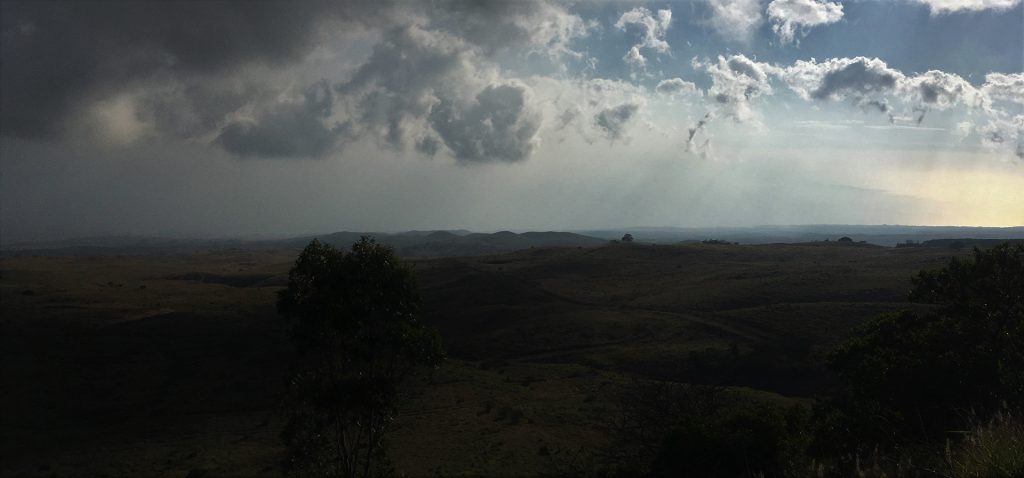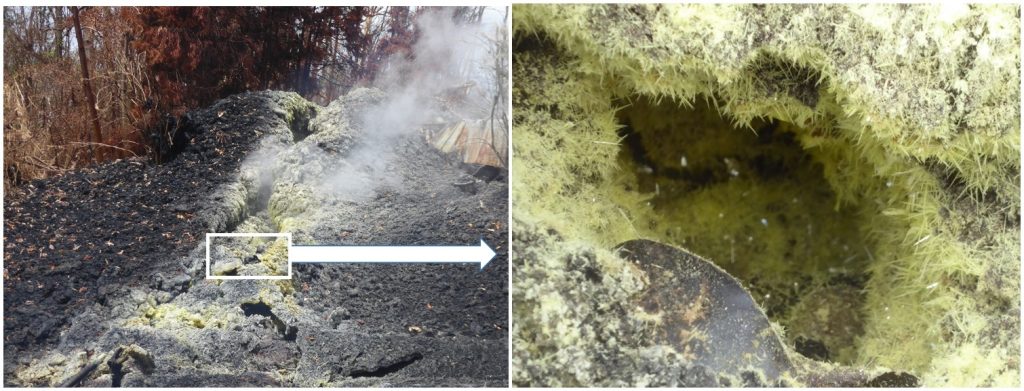USGS HVO Volcano Watch
Volcano Watch is a weekly article and activity update written by U.S. Geological Survey Hawaiian Volcano Observatory scientists and affiliates.

Edge of the Kīlauea vog plume near Waikoloa Village on the west side of Hawaiʻi Island as it is blown by trade winds across the island and toward the Pacific Ocean. For more information on sulfur dioxide emissions and vog. USGS photo by A. Lerner, June 23, 2018.
Many forms of sulfur are found on Kīlauea Volcano
For many Hawai‘i residents, interactions with Kīlauea Volcano’s eruptions is through vog—a hazy mixture of sulfur dioxide gas and sulfate particles. However, sulfur on Kīlauea is not limited to vog components.
Sulfur is an exceptional element in that its atoms have a range of electron configurations (commonly referred to as oxidation states). This results in spectacularly diverse forms of sulfur, many of which are found on Kīlauea, some of which are described below.
Sulfur dioxide (SO2) and vog: Vog (volcanic air pollution) has impacted the Hawaiian Islands ever since island landmasses rose above the ocean’s surface, which allowed volcanic gases to be released directly into the atmosphere.
As magma rises toward the surface, decreasing pressure on the molten rock causes dissolved sulfur and other volatile elements to form various gases. When magma reaches shallow depths, dissolved sulfur primarily forms SO2 gas. Once emitted into the air, SO2 reacts with oxygen, atmospheric moisture, sunlight, and other gases and particles to create a visible haze (vog) that is blown downwind. The levels of vog experienced across the islands is controlled by the amount of SO2 gas released and changing winds.

Continued degassing from fumaroles at fissures on Kīlauea Volcano’s lower East Rift Zone produce native sulfur crystals when sulfur dioxide and hydrogen sulfide gases react and cool upon reaching the surface. The delicate sulfur crystals are 0.2-0.6 inches long. USGS photos by A. Lerner, 2018.
With Kīlauea’s ongoing lower East Rift Zone (LERZ) eruption and continued summit subsidence, SO2 emissions from the volcano have increased substantially—levels are now three to seven times higher than before the current activity began. Most of the SO2released on the LERZ occurs as lava is erupted from the active vents (fissures), although some SO2 is also emitted from the lava flows and ocean entry.
High gas emissions from the LERZ, primarily fissure 8, have resulted in increased vog and poor air quality downwind of the active vents. During typical trade winds, vog is carried south and west across the Puna District, then on toward Kaʻū and along the Kona coast, before being blown farther offshore. During certain wind conditions, vog has reached the summit of Maunakea and stretched across the Pacific as far away as Guam, about 4,000 miles from Kīlauea.
Hydrogen sulfide: When SO2 gas from shallow magma interacts with groundwater, the SO2 dissolves and can be re-emitted as hydrogen sulfide gas (H2S). This process produces the rotten egg scent noted at hydrothermal features on Kīlauea, such as Sulphur Banks in Hawai‘i Volcanoes National Park, and at steam vents along the volcano’s lower East Rift Zone, many of which predate the current LERZ eruption.
Human noses are highly sensitive to H2S, and most people can detect its rotten egg smell at a level of around one part per billion (ppb). This concentration is about ten thousand times lower than levels considered to be hazardous to health. In fact, our noses are more sensitive than any instruments we use to quantitatively measure H2S.
Native Sulfur: Sulfur is also stable in its elemental form, known as “native sulfur.” This form of sulfur is a yellow crystalline solid that has historically been referred to as “brimstone.” At Kīlauea, native sulfur is found at volcanic fumaroles, such as Sulphur Banks, where both SO2 and H2S gases are emitted.
Native sulfur, formed from a chemical reaction (SO2 + 2H2S = 3S + 2H2O), is stable in solid form only at relatively low volcanic temperatures of less than 115 degrees Celsius (about 240 degrees Fahrenheit). Above this temperature, sulfur melts, forming a vivid orange liquid. At hotter temperatures (near 200 degrees C, or about 390 degrees F), molten sulfur turns dramatic shades of red. If temperatures approach 450 degrees C (840 degrees F) and atmospheric oxygen is present, native sulfur burns, forming sulfur dioxide (S + O2 = SO2).
Sulfur dioxide (along with sulfate particles in vog), hydrogen sulfide, and native sulfur all form at both Kīlauea Volcano’s lower East Rift Zone and summit depending on vent temperatures and how much the gases interact with groundwater. Additionally, sulfur binds with many other elements to form organic and inorganic gases and minerals, which are beyond the scope of today’s Volcano Watch.
So, while vog and SO2 gas emissions have been on our minds for many years, and especially since May 3, 2018, it’s worth noting that they are just some of the many forms of sulfur at Kīlauea.
Volcano Activity Updates
On Kīlauea Volcano’s lower East Rift Zone, lava continues to erupt primarily from Fissure 8. As of July 13, the channelized lava flow west of Kapoho Crater was the main ocean entry at the southern edge of the flow, and despite no visible surface connection to the fissure 8 channel, lava was oozing out at several points on the 3.7 miles wide flow front into the ocean. Sulfur dioxide emissions from the active fissure remains high. Residents in the lower Puna District of Hawai‘i Island should stay informed and heed Hawai‘i County Civil Defense closures, warnings, and messages.
At Kīlauea’s summit, collapse explosions occurred during the past week, producing ash-poor steam plumes less than a 1,000 feet above the ground. The energy released by these events were equivalent to earthquakes of magnitudes 5.1 to 5.4. Inward slumping of the rim and walls of Halema‘uma‘u continues in response to ongoing subsidence at the summit, resulting in frequent felt earthquakes.
At Mauna Loa, HVO seismic and deformation monitoring networks have recorded near background levels of seismicity and ground motion for at least the last six months. These observations indicate that the volcano is no longer at an elevated level of activity. Accordingly, HVO dropped the Mauna Loa alert level to NORMAL and the aviation color code to GREEN on June 21, 2018. HVO continues to monitor the volcano closely and will report any significant changes.
Please visit HVO’s website for past Volcano Watch articles, Kīlauea daily eruption updates, Mauna Loa weekly updates, volcano photos, maps, recent earthquake info, and more. Call for summary updates at (808) 967-8862 (Kīlauea) or (808) 967-8866 (Mauna Loa). Email questions to [email protected].













